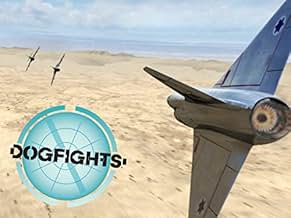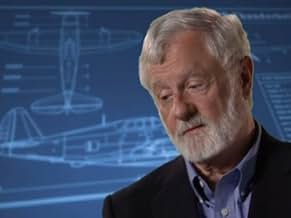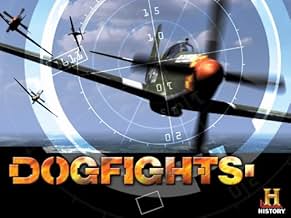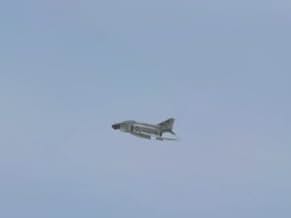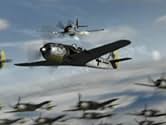Unisciti a noi e ricrea fantastiche battaglie navali aeree e moderne usando la moderna animazione al computer e nel processo scopri la storia della tecnologia di trasporto militare, le tatti... Leggi tuttoUnisciti a noi e ricrea fantastiche battaglie navali aeree e moderne usando la moderna animazione al computer e nel processo scopri la storia della tecnologia di trasporto militare, le tattiche create e le persone che le usano.Unisciti a noi e ricrea fantastiche battaglie navali aeree e moderne usando la moderna animazione al computer e nel processo scopri la storia della tecnologia di trasporto militare, le tattiche create e le persone che le usano.
Sfoglia gli episodi
Recensioni in evidenza
It's a marvelous recreation of aerial combat from World War I through modern conflicts. I can't think of any computer-generated graphics (or whatever they're called) that have so convincingly recreated the aerobatics of combat aircraft and explained them so clearly. The aluminum surfaces glisten. The sun always seems to be shining, and when an airplane turns, the shadows on its wings turn with it. If the image is rearward, looking over a wing, you can see the elevators tip up and down slightly as the aircraft climbs or dives. Every detail on the aircraft seems exact. It's beautifully done. The graphics are nicely supplemented by newsreel and combat footage.
The narration takes us through the events, one by one, and sometime the participants tell us what they were thinking and what their intentions were. There is some sentiment, not much, in these recollections. The general layout of the conflict is described -- we learn why Mig Alley was so dangerous and why heavy bombers over Europe required fighter escort -- but the politics are absent. For each engagement, the principal characteristics of each airplane are described, and enemy aircraft get their just due.
One major observation and one minor. In the episodes I've seen, the victors were all Americans or American allies and the enemy lost, even when the opponent receives credit for being "an expert pilot." We sink the Bismark. We sink the Yamato. We shoot down every enemy airplane in sight, it seems, without losing any of our own. Why Rickenbacker and not von Richthofen, for instance? I wonder if it isn't somehow dangerous for younger and more impressionable viewers to watch a series like this in which we see a simulacrum of a video game in which we always win. The scientific studies of media presentations on real life have produced complex and mixed results. But I wonder. Is there a covert message? And, if so, is it: "Let's go to war and play Dogfight"?
One of the pilots interviewed mentions the need in a successful fighter pilot for "skill, aggressiveness, and the fighting spirit." I don't know what a fighting spirit is but fighter jocks seem to have the other two traits in spades. No power on earth could put me in a situation as dangerous as aerial combat. It takes a heap of persuasion to get me off the ground at all.
An ancillary note: A curious psychological study of fighter aces in the Korean war found a disproportionate number to be later-born children. There is weak support from other studies showing that later children are a little more open, agreeable, and maybe adventurous. Bomber pilots are more often first borns. George H. W. Bush has said that he preferred flying a Gruman Avenger with a three-man crew during World War II because he wanted the company. That puts him in the wrong slot, an anomaly, because he was the second son. He should have wanted to fly fighters but I'll give him a pass.
The narration takes us through the events, one by one, and sometime the participants tell us what they were thinking and what their intentions were. There is some sentiment, not much, in these recollections. The general layout of the conflict is described -- we learn why Mig Alley was so dangerous and why heavy bombers over Europe required fighter escort -- but the politics are absent. For each engagement, the principal characteristics of each airplane are described, and enemy aircraft get their just due.
One major observation and one minor. In the episodes I've seen, the victors were all Americans or American allies and the enemy lost, even when the opponent receives credit for being "an expert pilot." We sink the Bismark. We sink the Yamato. We shoot down every enemy airplane in sight, it seems, without losing any of our own. Why Rickenbacker and not von Richthofen, for instance? I wonder if it isn't somehow dangerous for younger and more impressionable viewers to watch a series like this in which we see a simulacrum of a video game in which we always win. The scientific studies of media presentations on real life have produced complex and mixed results. But I wonder. Is there a covert message? And, if so, is it: "Let's go to war and play Dogfight"?
One of the pilots interviewed mentions the need in a successful fighter pilot for "skill, aggressiveness, and the fighting spirit." I don't know what a fighting spirit is but fighter jocks seem to have the other two traits in spades. No power on earth could put me in a situation as dangerous as aerial combat. It takes a heap of persuasion to get me off the ground at all.
An ancillary note: A curious psychological study of fighter aces in the Korean war found a disproportionate number to be later-born children. There is weak support from other studies showing that later children are a little more open, agreeable, and maybe adventurous. Bomber pilots are more often first borns. George H. W. Bush has said that he preferred flying a Gruman Avenger with a three-man crew during World War II because he wanted the company. That puts him in the wrong slot, an anomaly, because he was the second son. He should have wanted to fly fighters but I'll give him a pass.
10freyw
A must-see for any aviation buff. This series uses the latest computer technology to recreate history's greatest air battles, including Guadalcanal (WWII), Mig Alley (Korea), Operation Bolo (Vietnam), the Six-Day War, and the exploits of the Flying Tigers. The series also makes good use of archival footage from the period to help illustrate the tactics and machines. The recreations are expertly done and very exciting (the "camera" even shakes when a plane flies by). Personally, I've been interested in this sort of thing since I was a kid, and this is probably the best show I've ever seen. If you like military aviation, I guarantee you won't be disappointed.
Although the series is high in technical proficiency and detail to re-animate air battles, there is an almost complete of historical balance. The focus of most chapters is on American aviators as if they were repeating the "Mariana's turkey shot" through the ages. Only a few chapters are devoted to Israeli or German and Japanese odds-and-ends (Me-163, kamikaze, etc.). Almost no mention is done of German, Russian, Japanese, Chinese and even North Vietnamese Aces that top all-time aerial combat Aces lists. They even neglect traditional allies as the British and the French. There are very detailed accounts of aerial battles from the "other guys" point of view that should be included to have a really "Historical balance" of aerial warfare.
Great documentary series.
As the name suggests, a documentary series on aerial dogfights. Includes World War 1, World War 2, Korean War, Vietnam, 6 Day War, Yom Kippur and the two invasions of Iraq. Also has different forms of aerial combat, including naval and night-fighting.
Good narration, great CGI and good, relevant stories. Often shows a progression in tactics within the one episode.
About the only negative is that it is very US-centric. Most of the dogfights shown involve US pilots. No Red Baron (if I recall) and very little about the myriad of German Aces of WW2.
As the name suggests, a documentary series on aerial dogfights. Includes World War 1, World War 2, Korean War, Vietnam, 6 Day War, Yom Kippur and the two invasions of Iraq. Also has different forms of aerial combat, including naval and night-fighting.
Good narration, great CGI and good, relevant stories. Often shows a progression in tactics within the one episode.
About the only negative is that it is very US-centric. Most of the dogfights shown involve US pilots. No Red Baron (if I recall) and very little about the myriad of German Aces of WW2.
Just started watching the documentary "Dogfights" and the first one I saw was about the Thunderbolt against the FW-190. I must say that I have to agree with the majority of the other reviews that based on the one program I have seen it is totally biased towards the American pilots and planes. The Americans who did take part in the war certainly sacrificed a lot and deserve all the praise they get. It's unfortunately some of the so called historians and documentaries that put it all out of whack with their inability to see beyond their nose. Besides that I have never understood why some film companies have to scale down the picture size when recounting something in the past. In this documentary the actual black and white pictures were framed by some sort of background. It does nothing to enhance the viewing experience and is a bit of an irritation. The worst part of the program and which was a real disappointed was the pilot who tried to describe the dogfight while flying. The noise of the engine just made the whole thing worse. Well this is one series that I am not going to watch.
Lo sapevi?
I più visti
Accedi per valutare e creare un elenco di titoli salvati per ottenere consigli personalizzati
- How many seasons does Dogfights have?Powered by Alexa
Dettagli
- Data di uscita
- Paese di origine
- Sito ufficiale
- Lingua
- Celebre anche come
- Párbaj az égen
- Azienda produttrice
- Vedi altri crediti dell’azienda su IMDbPro
- Colore
Contribuisci a questa pagina
Suggerisci una modifica o aggiungi i contenuti mancanti



